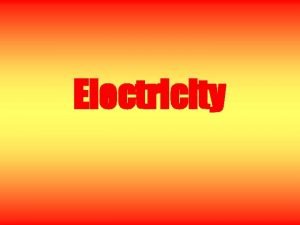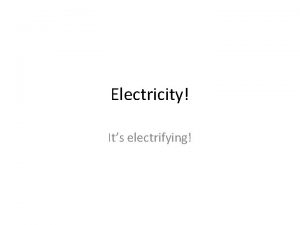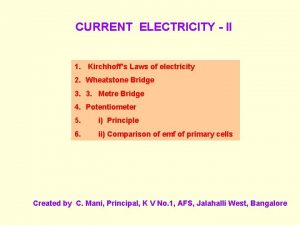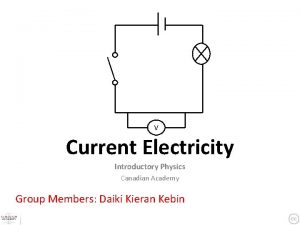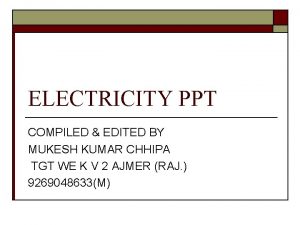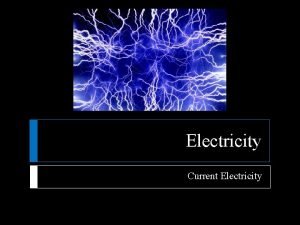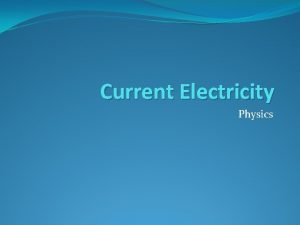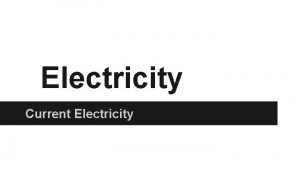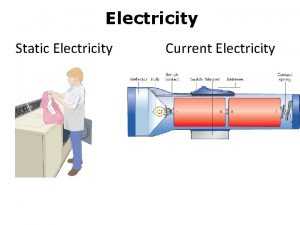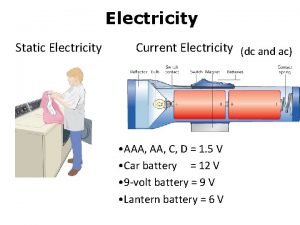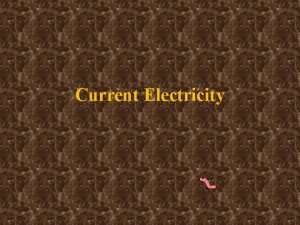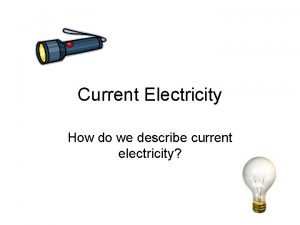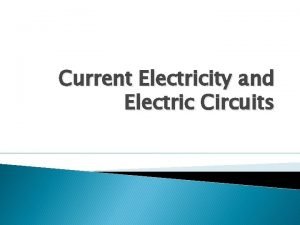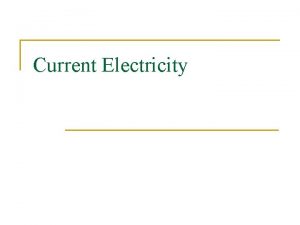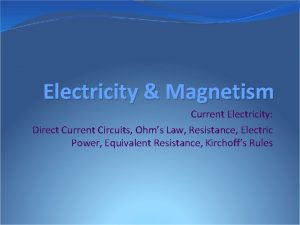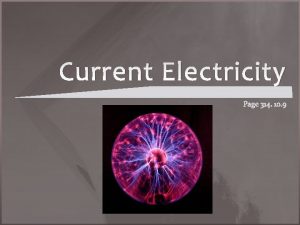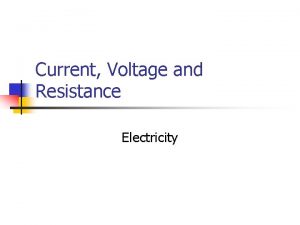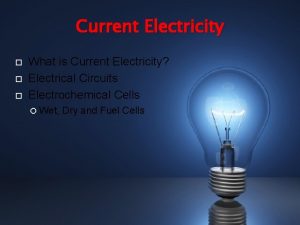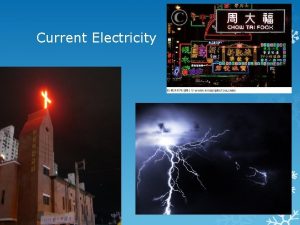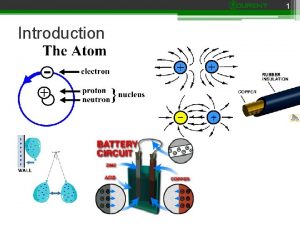Current electricity cell In current electricity a cell




















- Slides: 20

Current electricity

cell • In current electricity a cell means an electrochemical cell. Cell is a device by which chemical energy is converted into electrical energy.

Battery • Main type: storage battery • Date: 1881 • a cell or connected group of cells that converts chemical energy into electrical energy by reversible chemical reactions and that may be recharged by passing a current through it in the direction opposite to that of its discharge - called also storage cell.

Type of batteries IThe primary battery converts chemical energy to electrical energy directly, using the chemical materials within the cell to start the action. IThe secondary battery must first be charged with electrical energy before it can convert chemical energy to electrical energy. IThe secondary battery is frequently called a storage battery, since it stores the energy that is supplied to it.

Lead acid battery • Electrolyte for the most part distilled (pure) water, with some sulfuric acid mixed with the water. • Electrodes must be of dissimilar metals. • An active electrolyte.

Series Connected Batteries/cells • Positive terminal of one cell is connected to the negative terminal of the next and so on…, is called a series connected battery. • External circuit is taken from –ve terminal of 1 st cell and +ve terminal of last cell. • All current pass through each cell, • The voltage/EMF of this type of battery is the sum of a individual cell voltages. • V= v 1+v 2+v 3……. vn • internal resistance of battery is sum of internal resistance of individual cells.

Parallel Connected Batteries/cell • Connect the negative terminal from one cell to the negative of the next cell & so on. • Connect the positive terminal to the positive terminal of next & so on, is parallel connected. • The current pass through the external circuit from a common point where the negative terminal are connected together to a common point of junction of +ve terminals. • Voltage/EMF remains constant as that of single cell and the current is cumulative. • V= v 1= v 2= v 3…… vn • Internal resistance of battery reduced to less than that of one cell.

Series-Parallel Connections SERIES PARALLEL SERIES-PARALLEL

Series and Parallel Batteries • Parallel connection – increases the energy capacity of the battery set. – Cells must be matched for voltage – unmatched cells result in voltage with only internal resistance. • Series-Parallel connections – combination of series and parallel calculations

Serial and Parallel batteries • In series, the voltage is increased - the sum of the cells in series – Energy capacity is the same as that of a single cell (current = electrons/second – if unmatched cells are connected in series, the capacity will be that of the weakest cell.

Cells • • Positive electrode Negative electrode Electrolyte Separator

Basic primary wet cell • The metals in a cell are called the electrodes, and the chemical solution is called the electrolyte. • The electrolyte reacts oppositely with the two different electrodes • It causes one electrode to lose electrons and develop a positive charge; and it causes one other electrode to build a surplus of electrons and develop a negative charge. • The difference in potential between the two electrode charges is the cell voltage.

Dry cell • Uses An electrolytic paste. • The electrolytic paste reacts with the electrodes to produce a negative charge on one electrode and a positive charge on the other. • The difference of potential between the two electrodes is the output voltage.

DRY-CELLS Not Rechargeable As the reactants inside them become used up in chemical reactions, the output from these batteries gradually falls. Once all the reactants have been used up, these batteries go “flat” and cannot supply electrical energy anymore.

RECHARGEABLE Usually maintain a constant output until just before they go flat. E. g. Car batteries: they are constantly recharged while the car is moving, so the lights and horn will always work. Once flat, it can be connected to a recharger. This uses electrical energy to reverse the chemical reactions that happened in the battery while it was in use. E. g. Mobile phones, MP 3 players etc: must be recharged at regular intervals. It is usually recommended that such batteries should almost be flat before recharging. This allows the battery to be fully charged again.

Which are best? Non-rechargeable Rechargeable cheap to buy often expensive to buy can only be used once can be used many times expensive to use in the long run cheap in the long run as they as more are needed (high cost / can be re-used (low cost / performance ratio) output falls gradually with time output stays constant until almost flat disposal of many batteries creates a lot of chemical pollution disposal of fewer batteries creates less chemical pollution

The Leclanche dry cell • There are various type of cell, different types made from different materials and giving different EMFs, but that in common use is the dry Leclanche cell. • This consists of zinc and carbon electrodes in a solution of ammonium chloride. The carbon replaces the second metal and is surrounded by a mixture of powdered carbon and meganese dioxide. • The ionic movement within cell results in zinc acquiring a negative and carbon a positive charge, the p. d between them being 1. 5 volts. • in dry Leclanche cell zinc forms the outer case of cell and wire coming it is negative terminal. • The carbon electrode is a rod in the center of cell and its summit forms positive terminal.

electrolytes • When charging first started, electrolysis broke down each water molecule (H 2 O) into two hydrogen ions (H+) and one oxygen ion (O-2). • The positive hydrogen ions attracted negative sulfate ions (SO 4 -2) from each electrode. • These combinations produce H 2 SO 4, which is sulfuric acid.

Electrolysis • The producing of chemical changes by passage of an electric current through an electrolyte. Electrolysis • When charging fist starts, the current flowing through the battery causes electrolysis of the water. • The water molecules (H 2 O) begin to break down into their constituent ions. • For each negative oxygen ion (O-2) that is produced, there are two positive hydrogen ions (H+), so that the electrolyte is neutral.

 Static electricity and current electricity
Static electricity and current electricity Electricity n
Electricity n Electricity and magnetism vocabulary
Electricity and magnetism vocabulary What is electricity
What is electricity Difference between charge and electric charge
Difference between charge and electric charge Current electricity def
Current electricity def Bill nye friction worksheet
Bill nye friction worksheet Current electricity
Current electricity What is current electricity in physics
What is current electricity in physics Current electricity ppt
Current electricity ppt Venn diagram of climate and weather
Venn diagram of climate and weather Line current and phase current
Line current and phase current Line vs phase voltage
Line vs phase voltage Energy band diagram of pn junction diode
Energy band diagram of pn junction diode Ac theory 3 lesson 4
Ac theory 3 lesson 4 Drift vs diffusion current
Drift vs diffusion current Intrinsic semiconductor
Intrinsic semiconductor The jfet always operates with
The jfet always operates with Line currents
Line currents Holding current and latching current
Holding current and latching current Drift current density unit
Drift current density unit



